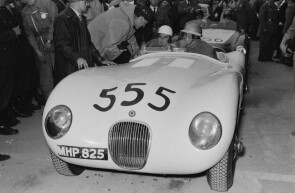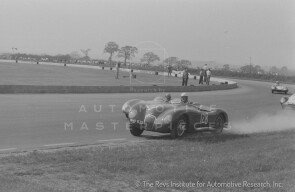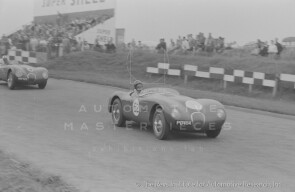
1952 Jaguar C-type
ON/OFF
Why am I an Automotive Masterpiece?
J. Movie cars
Mille Miglia 1953 - Un film Shell (IT)
L. Limited edition cars
no. 52 manufactured, 8th built
In 1950, sensing the image boost provided by a victory at the 24 Heures du Mans, where three specially prepared XK 120 OTSs had performed admirably, Jaguar's management devised an action plan for a new racing car: Sir William Lyons, the company's managing director, and Frank Raymond Wilton "Lofty" England, the manager who a year earlier had founded Jaguar's Engineering Competition Department, its first official racing division, tasked engineer William "Bill" Heynes with designing the racing version of the XK 120, with the precise goal of winning the French endurance race. Heynes decided to design a race car that, leveraging much of the XK 120 OTS's mechanics, would address its weaknesses: the separate chassis body, heavy and not very aerodynamic, and the brakes that were not very durable. Thus, the XK 120-C was designed and built, where C stands for “Competition”, which was soon renamed C-type. It was put into regular production on its own assembly line, alongside the MK VII saloon and the XK 120, and sold in England for £2327. Thanks to regular production and a competitive price, between 1951 and 1953, 53 units were made, of which 10 were allocated to the official Jaguar racing team and the remaining 43 to private drivers, especially US ones. The new car's mechanical components from the XK 120 (engine, gearbox, steering, front suspension) were enhanced by an entirely new tubular frame, lighter and more durable thanks to box-section reinforcements at the most stressed points, designed by Bob Knight. The body, designed by Malcolm Sayer, was made entirely of aluminum, making it lighter and better profiled than the XK 120 OTS's body. The cockpit was spartan: every unnecessary detail was absent for weight reasons. In front of the two leather-covered bucket seats, there was a complete set of instruments: speedometer/odometer, tachometer, oil pressure and temperature gauge, fuel level and water temperature gauge. The occupants were protected only by two small fold-down aeroscreens and a low windshield. The hood and front fenders were united into a single piece, which opened up providing wide access to the mechanics. The trunk space (non-existent) was occupied by a 178-liter fuel tank, with a quick-release cap on top of the fender. The front suspension from the XK 120 utilized deformable quadrilaterals and longitudinal torsion bars; the novel rear suspension used a classic live axle scheme but with a transverse torsion bar, longitudinal reaction rods, and a single triangular reaction arm to contain lateral shaking. This last component was replaced, starting from the end of 1952, by a Panhard rod. The shock absorbers were hydraulic telescopic at both front and rear. The steering was rack and pinion. The braking system was still drum brakes on all wheels but improved thanks to better cooling, guaranteed by the adoption of 6.00/6.50x16" wire wheels, and by the adoption of an automatic slack recovery system. During production, the drum brakes were replaced by disc brakes, making the C-type the first car in the world to successfully use them in racing and on the road. The engine and 4-speed gearbox, originating from the XK 120, were modified for racing: the double overhead camshaft, XK series 6-cylinder inline engine, 3442 cc, fed by two SU H8 carburetors was refined by adopting a new cylinder head, new camshaft profiles, dual side exhausts, and a more accurate general tuning, reaching 200 hp at 5800 rpm and 298 Nm of torque at 3900 rpm instead of the original engine’s 160 hp at 5000 rpm and 262 Nm of torque at 2500 rpm. The car weighed only 1000 kg and was capable of exceeding 230 kmh. The C-type became a protagonist at the 24 Heures du Mans from its debut in 1951. "Lofty" England meticulously prepared the race, bringing three cars to the Circuit de La Sarthe: the first for Stirling Moss - Jack Fairman, the second for Leslie Johnson - Clemente Biondetti, and the third for Peter Walker - Peter Whitehead. Despite excellent trials, the C-types of Moss and Biondetti were forced to retire due to mechanical failures. However, Walker - Whitehead’s car won with a 9-lap lead over the second-place finisher, having led for 16 hours in the rain. After the great victory, Jaguar regularly put the car on sale but officially participated in few other competitions. A notable achievement was a one-two finish at the RAC Tourist Trophy raced at the Dundrod circuit with the C-types of Stirling Moss, first, and Peter Walker, second. Between the 1951 and 1952 sports seasons, Jaguar updated the car: the triangular reaction arm was replaced with a Panhard rod and the two SU H8 carburetors were replaced with three twin-barrel Weber 40 DCO3 carburetors; power increased to 220 hp at 5750 rpm. Development began, in collaboration with Dunlop, on disc brakes. The reliability of the new braking system in races was tested by Stirling Moss and test driver Norman Dewis at the 1952 Mille Miglia. Despite retiring from the race, the two gained enough experience to refine the revolutionary components. For the 1952 24 Heures du Mans, fearing competition from the new Mercedes-Benz W194, the "official" C-types were further modified with a new cooling system and a more aerodynamic body. However, the modifications were not sufficiently tested, and, due to overheating problems, the three cars in the race had to retire. The C-type returned to victory, with a standard body, at the 1952 GP of Reims with Stirling Moss; it was the first official victory for a car equipped with disc brakes. In 1953, all official C-types were equipped with Dunlop disc brakes on all four wheels and, thanks also to these components, the C-type repeated its success in the 24 Heures du Mans achieved in 1951. "Lofty" England presented the same line-ups as in 1952: Peter Walker - Stirling Moss, Peter Whitehead - Ian Stewart, and Tony Rolt - Duncan Hamilton. Hamilton and Rolt won the race, setting a new record with an average speed of over 100 mph: specifically, at 105.85 mph (170.3 km/h). The Jaguar C-type was subsequently replaced by the D-Type, which was a direct evolution, but continued to compete for years in the hands of numerous private drivers. In 2021, 50 years after its debut, Jaguar, through its Classic department, produced 8 "new" C-types, called C-type Continuations, built to the same specifications as the 1953 version.
The 1952 Jaguar C-type with chassis no. XKC 008 (8th chassis of 52 built) was factory prepared for its first owner Leslie Johnson, a former official Jaguar team driver from 1949 to 1952. He was the first to win a race with an XK 120 and purchased XKC 008 as a private owner, then maintained it at his works (the notable ERA, Dunstable). Johnson began racing with the car immediately and entered the Monaco Grand Prix the same year. But the significant event happened the following year: in 1953, the Mille Miglia became a qualifying event for the World Championship, attracting foreign entrants such as Leslie Johnson. John Lea, a former mechanic from Jaguar's Experimental Department who had recently left Jaguar but was leading the Gretton Garage, was in high demand to prepare cars for private owners. One of his first tasks was to equip Johnson’s XKC 008 with a Laycock overdrive unit for that race, never tried by Jaguar on its works cars. The car participated in the Mille Miglia with Johnson and McKenzie driving and also featured in the movie “Mille Miglia 1953, un film Shell” but was forced to retire. Between 1953 and 1954, the car became the property of another driver, John Hogg, who used it extensively in the years to come, especially in British (and French) events, achieving excellent class placements until 1956, when it was owned by the late John Blunsden, publisher of Motor Racing Pubblications. That same year, the car was advertised for sale in Autosport painted green, and was acquired by another racing driver, John Bekaert, who achieved first-place finishes in British championships until 1958. The car was advertised again for sale, now painted red, with Appendix C full road equipment, a new engine. By 1960, it is known that the car was (probably) owned and restored by Jackie Epstein who advertised the car in Autosport, 13 September 1963 as “overdrive, full width screen, recent paint job”. It was then owned by Charles Stoker, David Merifield, Patricia Hall and, maybe, Miss P. Richardson and Mr Littler. Sold in 1969 to Ian Barclay Wilson, the car spent much time in the care of Aubrey Finburgh of Classic Autos. XKC 008 reappeared in the late 80s at events for historic cars. But its true “resurrection” began in the early 2000s: the car boasts numerous appearances at major events for historic cars: at Silverstone, Goodwood, Le Mans, Brands Hatch, Monaco, and, naturally, Mille Miglia. In 2019, the car received a FIVA passport. Its career, as a new race car first, and a historic one later, is still to be thoroughly explored, given the number of events it has participated in. XKC 008 is featured in important specialized books such as Sandro Binelli’s Mille Miglia’s Chassis, Volume III.





